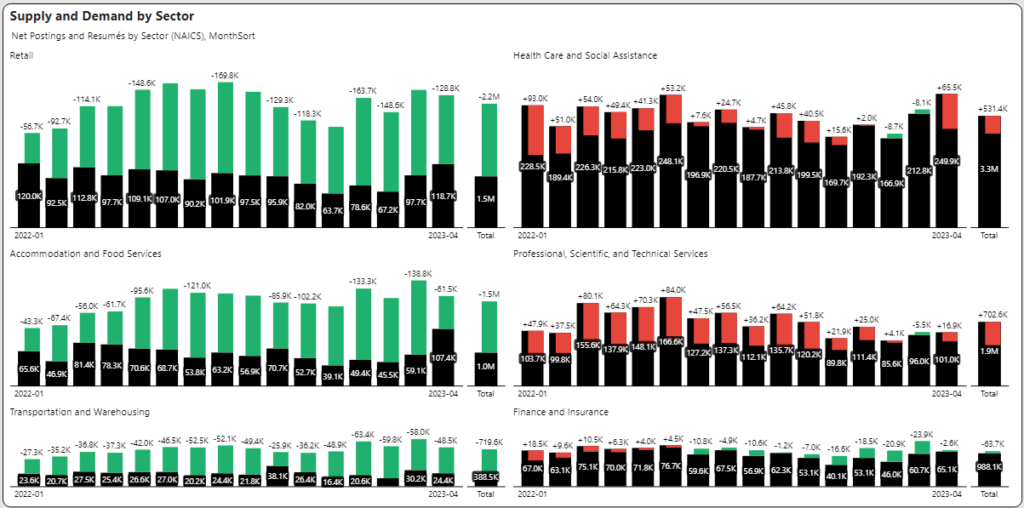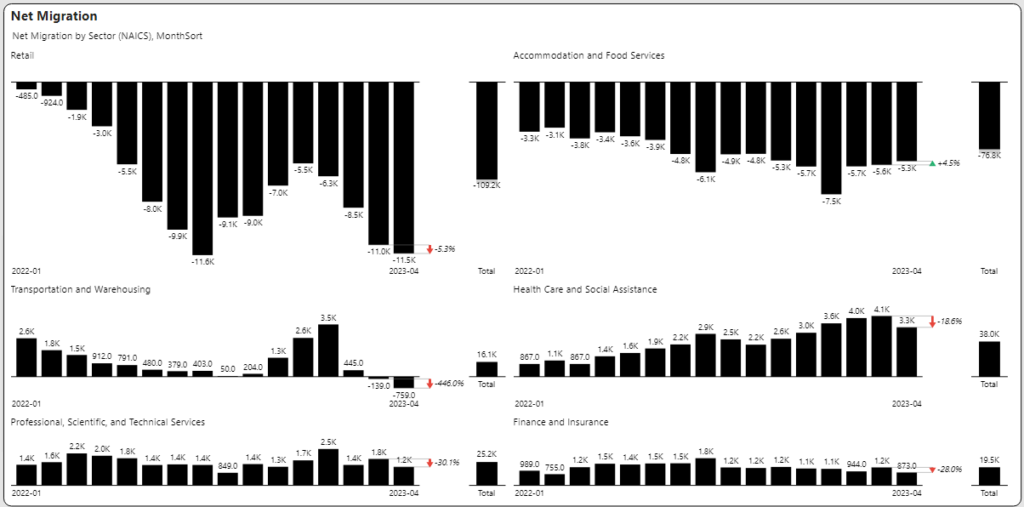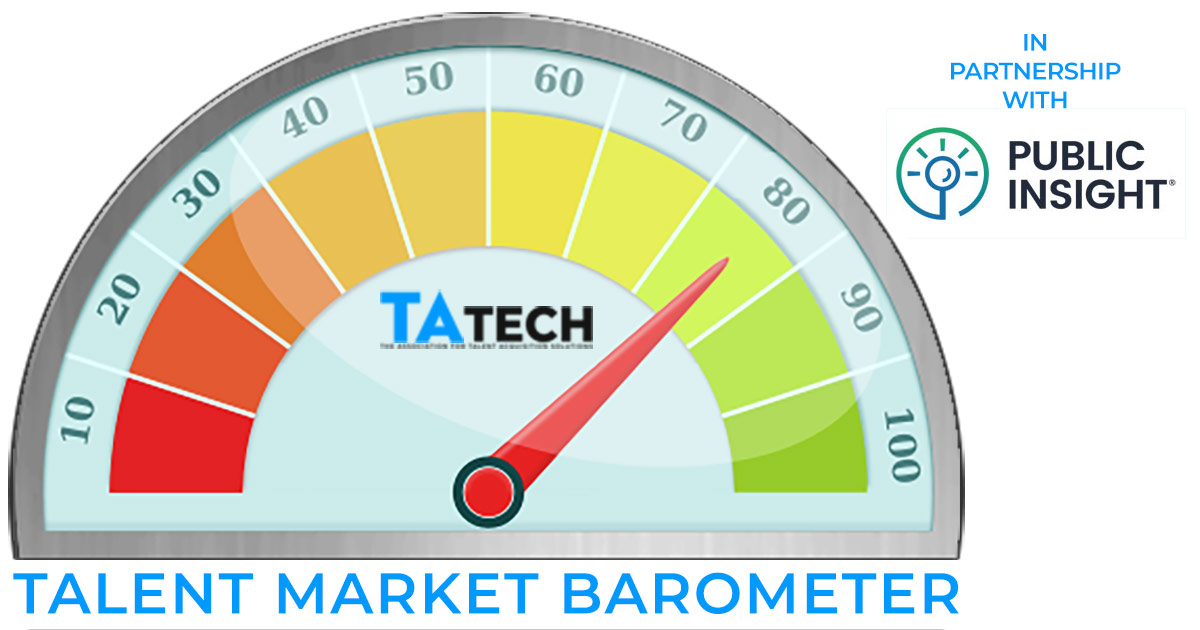A joint project of TAtech and Public Insight(R)
In Brief
The TAtech Talent Market Barometer is based on two metrics: the Supply-Demand Ratio and Net Migrations in the U.S. talent market. The Supply-Demand Ratio compares the number of job seekers with resumes to the net number of jobs posted in a select set of workforce sectors. Net Migrations measures the number of people with resumes entering or leaving those same sectors.
In April, the Supply-Demand Ratio and Net Migrations data indicate that the trend in the talent market is moving in a negative direction for recruiters. Based on that assessment, we think it would be wise for recruiters to carry an umbrella. The current TAtech Barometer readings indicate they will see a deteriorating talent market in the days ahead. Conditions may be different in your specific location or for your specific target talent cohorts.
What does a deteriorating Supply-Demand Ratio mean?
Among the six workforce sectors we monitor (which comprise approximately 50 percent of the U.S. working population, according to the U.S. Census Bureau), four had more job seekers than job postings in April. Typically, such positive supply-demand ratios in a majority of the monitored sectors translates into a favorable talent market for recruiters. However, while the majority did show positive ratios, that reading is down from the situation in March when all six of the sectors had positive ratios. Therefore, the Supply-Demand Ratio for May actually indicates a deteriorating talent market for recruiters.
A favorable supply-demand ratio existed in the following sectors:
- Accommodation & Food Services
- Finance & Insurance
- Retail
- Transportation & Warehousing
There was an unfavorable Supply-Demand Ratio in:
- Healthcare & Social Assistance
- Professional, Scientific & Technical Services
Equally as troubling, while there were more job seekers than job postings in the Accommodation & Food Services, Finance & Insurance, Retail, and Transportation sectors, the ratio of net new job postings to job seekers declined in all of them except Transportation & Warehousing. This situation could be a one-time condition, of course, but as a minimum, it also represents a negative talent market trend for recruiters in the future.

What does a deteriorating trend in Net Migrations mean?
In the six workforce sectors we monitor, five of the sectors had fewer people with resumes coming into the job market in April, which reverses the gains recorded in March when four of the sectors actually had more people coming into the market. These shifts ranged from just a negative 5.3 percent in Retail to a whopping 446 percent decline in Transportation & Warehousing. Only Accommodation & Food Services had a positive Net Migration and at 4.5 percent, it was modest. For that reason, the Net Migration reading for May is also for a deteriorating talent market for recruiters.
Those sectors with a negative net migration trend were:
- Finance & Insurance
- Healthcare & Social Assistance
- Professional, Scientific & Technical Services
- Retail
- Transportation & Warehousing
The sector with a favorable net migration trend was:
- Accommodation & Food Services
As with the supply-demand ratio readings, there were also troubling signs of possible future declines in net migration across all of the six monitored sectors. The average decline in job seekers with resumes entering the sectors was 105.6 percent, with Transportation & Warehousing included, and 20.5 percent with that sector excluded. In effect, recruiters could be facing a significantly tighter talent market in the near to mid-term in sectors representing over 50 percent of the US workforce.

Our Forecast
Our forecast looks at the month-to-month changes in both the Supply-Demand Ratio and Net Migrations to forecast a talent market that is:
- Challenging for recruiters
- Deteriorating for recruiters
- Unchanged for recruiters
- Improving for recruiters
- Favorable for recruiters
The direction of the market from March to April 2023 is as follows for the six workforce sectors we monitor:
- Retail:
- Unchanged – Deteriorating market continued in April
- Accommodation & Food Services:
- Unchanged – Improving market continued in April
- Transportation & Warehousing:
- Unchanged – Deteriorating market continued in April
- Professional, Scientific & Technical Services:
- Changed – From Improving to Deteriorating market in April
- Finance & Insurance:
- Changed – From Improving to Deteriorating market in April
- Healthcare:
- Changed – From Improving to Deteriorating market in April
Based on these readings, our Talent Market Barometer Forecast for May is: Carry an umbrella. There is a Deteriorating Market for Recruiters.
Based on these readings, our forecast is for an Improving Market for Recruiters.
Job Market Data & Analytics: Public Insight provides job market insights that optimize recruiting and career strategies and improve talent acquisition.
Public Insight acquires the market data used in the Barometer from Indeed and Glassdoor (Recruit Holdings) as well as select government publications and then analyzes it to produce a broad range of in-depth metrics. The resulting data set provides a targeted 70 percent proxy for the talent market in the U.S.

